Are you familiar with the colorful, yummy-looking but slightly mysterious Japanese food and drink emojis? Today we’re going to demystify some of the popular Japanese food emojis you have come across over text or email messages, and hopefully, this will give you a fun introduction to the ever-evolving Japanese cuisine.
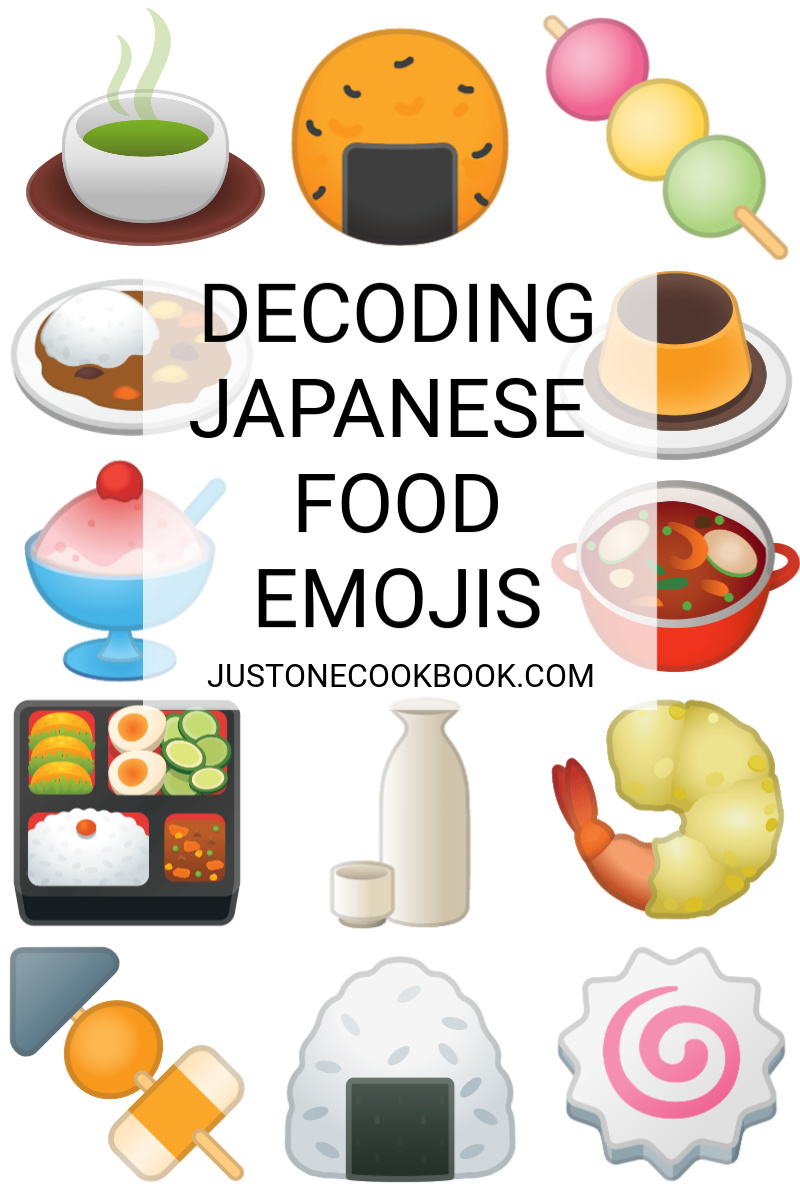
We are emoji aficionados over at Just One Cookbook, particularly Japanese food emojis. If you are a subscriber to our email newsletter or a follower of our Instagram, you’ve probably seen different graphic icons that accompany each recipe and travel & cultural post that we share. Not only do they illustrate the recipes and various topics in such a delightful way, but these emojis are also essentially a representation of Japanese culture.
Hungry for some steaming bowl of 🍜 or maybe some fresh 🍣? Let’s dig in!
Emoji Origin & Its Influence
Just like Super Mario which took the world by storm, Emoji is another digital invention by the Japanese in the late 1990s by a creator named Shigetaka Kurita. They are tiny pixel images that were initially used on mobile phones in Japan and the word ’emoji (絵文字)’ literally translates as “picture (絵) letter (文字)”.
These ‘picture letters’ are kawaii (cute in Japanese), playful, and imaginative. As the saying goes ‘A picture paints a thousand words’, it can’t be any more truth to that!
Rather than typing the text out, emoji has the power to capture your attention instantaneously. This is why it doesn’t take long for Emoji to infiltrate the modern world and become a sort of new language in human communication. I think the influence of emoji lies in its indigenous way of expressing one’s thoughts or emotions most succinctly and charmingly.
Different Groups of Emojis
These days you can find emojis being used in all types of devices and platforms. In general, these emoji or emoticons can be grouped into a few main groups: people (the smiley face), objects, nature, places, and symbols.
Japanese Food & Drink Emojis
Since they originated in Japan, you’d find a lot of emojis related to Japanese culture. And with food being an integral part of the culture, you could find many food and drink-related emojis in the collection. Depending on your familiarity with Japanese cuisine, some of these icons may be more recognizable than others.

Wondering what is the white and pink swirl emoji 🍥? What does 🍘 mean? What exactly are those colorful balls on a stick🍡? If you are curious about learning more, we’re going to decode these emojis in this post, and hopefully, it could well be your first step in discovering iconic Japanese foods. What’s more exciting? We even have recipes for most of the emoji you’re going to learn today!
Rice Ball Emoji

This triangular shape icon with a dark green square in the center is called the onigiri (おにぎり), also known as Japanese rice ball.
Onigiri is made from steamed rice formed into the typical triangular, ball, or cylinder shapes stuffed with a variety of fillings and usually wrapped with nori (dried seaweed). These rice balls are synonymous with sandwiches in Japan as they are portable and make a delicious quick snack or lunch on the go.
Some of the popular fillings for onigiri include umeboshi (pickled plum), salted salmon, and tuna mayo. You can easily pick them up from the airport, convenience stores, train stations, departmental stores, or even specialty stores in Japan as they make excellent travel food.
Did you know? Onigiri is not a type of sushi as they are made of plain steamed rice, while sushi is made of steamed rice seasoned with salt, sugar, and vinegar.
Wish to make these riceballs🍙 at home? Here are the recipes:


Ramen Emoji

It’s probably one of the most recognized Japanese food emojis these days due to the popularity of this food! Next time make my ramen recipe and text your friend with this 🍜 emoji!
Popular ramen recipes on Just One Cookbook 🍜:


Naruto (Fish Cake) Emoji
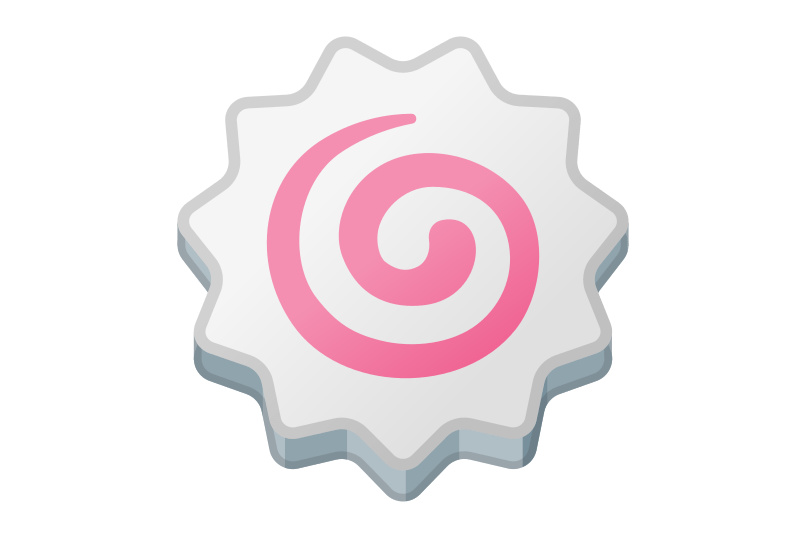
This pinwheel-shaped icon with a cutesy pink swirl is probably one of the most intriguing Japanese food emojis. It refers to a slice of Japanese Narutomaki (なると巻き) or Naruto, also known as Japanese fish cake that you often see as a topping served atop ramen and udon.
The fish cake is made with pureed whitefish that is cured, molded, and steamed into a small log with a sawtoothed pattern. On the inside of the cylinder fish cake is the decorative pattern of pink spiral swirls. You can purchase Naruto from the refrigerated section at the Japanese grocery stores. It is already pre-cooked and ready to use. To serve, slice the fish cake thinly and top a few slices over each noodle bowl before pouring the broth over.
Did you know? The fish cake is named after the tidal whirlpools of the Naruto Strait between Awaji Island and Shikoku in Japan.
Recipes featuring Naruto 🍥:


- Spicy Shoyu Ramen
- Kitsune Udon
- Oden (Japanese Fish Cake Stew)
- Chawanmushi (Japanese Savory Egg Custard)
Steamed Rice Emoji

When cooked properly, the Japanese short-grain rice grains cling to each other without becoming mushy, allowing you to easily pick up the rice with chopsticks. You’ll also notice a beautiful glossy sheen on the surface of the rice. These unique characteristics of Japanese short-grain rice are essential because they allow us to make dishes like rice balls (onigiri) and sushi that need to stay in one piece.
You can make perfectly cooked Japanese short-grain rice 🍚 using my recipes!


Gyoza Emoji

Gyoza (餃子) are Japanese pan-fried dumplings that are crisp and golden on the bottom and juicy inside. These meat-filled treats are easy to fold using one of the methods I show here. They’re so delicious and served with my savory dipping sauce.
Make delicious gyoza 🥟 at home!


Bento Box Emoji

This emoji should be easy to decipher. Even if you’re a novice to Japanese food, you can at least figure it has something to do with a Japanese lunch box. Known as bentō (弁当) or obentō (お弁当), the meal is packed in a compartmentalized box, usually consisting of rice with a variety of accompaniments such as grilled meat, fish or seafood, omelette or scrambled egg, vegetables, and fruits.
Compact and colorful, bento is the typical lunch that the Japanese bring to school or to work. But you can also purchase a bento box from convenience stores, train stations, and departmental stores in Japan. They make a filling and convenient food for a picnic or a long train ride.
Did you know? The little red circle in the middle of the rice you see on the emoji is a pickled plum (umeboshi). It has a very sour and salty flavor, which makes it a favorite pickle to serve with steamed rice or rice balls to awaken the palate.
What’s in your 🍱 today? Learn how to make bento lunch boxes with the tutorial and recipes below:


Nigiri Sushi Emoji

Nigirizushi (握り寿司), or Nigiri for short, is the most venerable in the sushi world. Sushi rice is formed into bite-size pillow shapes and then topped with fresh raw fish like tuna or salmon sashimi as you see on the emoji.
Although it is the most common type of sushi served at restaurants, nigirizushi requires practice and experience. In the pursuit of making stellar pieces of nigirizushi, sushi chefs put in many years to perfect the rice and knife skills to get the fish into an impeccable slice. It’s not the type of sushi that Japanese home cooks commonly make.
However, here are the easiest sushi 🍣 recipes you can make at home!
Tempura (Fried Shrimp) Emoji

Tempura (天ぷら) refers to seafood, chicken, and vegetables that have been coated with a light batter and deep-fried into golden crisp deliciousness. Some of the most popular tempura include shrimp tempura (as depicted in the tempura emoji) and sweet potato tempura. Tempura is not only enjoyed as a standalone dish, but they are also often served as part of donburi (rice bowl) or noodle soup.
Did you know? In Japan, you can even find specialized restaurants that serve only the best of the best tempura.
Wish to enjoy some crispy 🍤 at home? Don’t miss out on these mouthwatering tempura recipes:


Nabe (Hot Pot) Emoji

With steam drifting up from a warming soup pot, this emoji comes in handy when all you can think about is a hot pot of food on a chilly day. The graphic icon makes reference to nabe (鍋) or nabemono (鍋物), a variety of hot pot dishes that are very popular in Japan during the cold weather months.
Typically served from a clay pot or iron pot with simmering broth that is shared communally, nabe includes an amazing mixture of fresh vegetables, meat, seafood, tofu, soybean products, or seasonal ingredients.
It’s surprisingly easy to make nabe 🍲at home, and here are just some of the popular nabe recipes you should try:


Curry Rice Emoji

This may not be the most appetizing food emoji you’ve seen, but I can guarantee the real thing is so much more delicious than you could imagine. The emoji depicts the famous Kare Raisu (カレーライス) aka Japanese Curry Rice, characterized by the thick brown sauce that is served over fluffy steamed rice. The reddish circles are the red pickled daikon. Unlike Indian or Thai curry, Japanese curry has a stew-like consistency and a sweeter taste. It is also less spicy which is suitable for children. The curry is always served with rice.
Did you know? The curry was brought to Japan in late 1800 by the British. As always, the Japanese habitually adapted the curry to their version soon after. By the 1950s S&B Foods company introduced curry roux in block form and started selling instant roux everywhere, which resulting curry rice being a very popular dish people make at home.
You too can make Japanese curry 🍛 at home with these delicious recipes:


- How to Make Japanese Curry Roux from Scratch
- Japanese Chicken Curry & Instant Pot version
- Japanese Beef Curry
Oden Emoji

Loosely described as Japanese fish cake stew, Oden (おでん) is a type of one-pot simmered dish, which includes a variety of ingredients such as fish balls, fish cakes, deep-fried tofu, hard-boiled eggs, konnyaku, and vegetables gently cooked in a soy sauce based-broth. It is considered a comfort dish during winter in Japan.
Did you know? Oden is also known as a food stall dish, and it’s especially popular among the salarymen after work where they enjoy the hot food and sake with their coworkers. You can even buy oden from convenience stores.
Wish to enjoy this simmered dish 🍢 out of the comfort of your home? Don’t miss out the recipe:

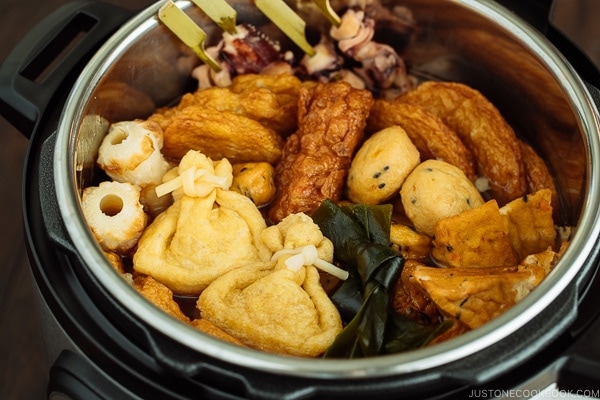
Yaki Imo Emoji

Japanese sweet potatoes, or satsumaimo (さつまいも, サツマイモ), have a distinct red-toned purple skin and off-white interior that turns yellow after cooking. When compared to orange sweet potatoes, purple sweet potatoes, or purple yams, the satsumaimo variety tends to be smaller and slender in size. They are also a lot sweeter with a chestnut-like flavor.
When Japanese sweet potatoes are baked or roasted, they are called yaki Imo (焼き芋) and they are perfectly tender, fluffy, and sweet!
These are my favorite satsumaimo 🍠 recipes!


Shokupan (Japanese Milk Bread) Emoji

Japanese Milk Bread is possibly the best version of soft white bread! With a milky-sweet taste and pillowy softness, shokupan (食パン) is enjoyed daily in Japan as breakfast toast and in sandwiches. Here‘s the perfect milk bread recipe in two styles: rounded top and flat top.
Try my shokupan 🍞 recipes!


Japanese Strawberry Shortcake Emoji

The Japanese strawberry shortcake (いちごのケーキ) is an iconic dessert in Japan, which is enjoyed on birthdays, all kinds of parties, and even Christmas!
Check out my Strawberry Shortcake 🍰 recipe!

Senbei (Rice Crackers) Emoji

Now that you’ve learned the dark green square on the icon is nori sheet (seaweed), you could probably describe the brown circle piece as toasty and snacky. And you’re right! This emoji refers to Senbei (煎餅) or rice crackers, a popular savory snack you can find in Japan. Come in various sizes and shapes, the rice crackers are typically brushed with a soy sauce glaze and grilled, then wrapped with a piece of nori.
Did you know? Senbei originated from China, where flour was used to make the crackers. But the Japanese loved rice so much that they started making crackers with rice instead.
You can easily find rice crackers 🍘 being sold at supermarkets and convenience stores in Japan. You can also make it at your home:

Dango Emoji
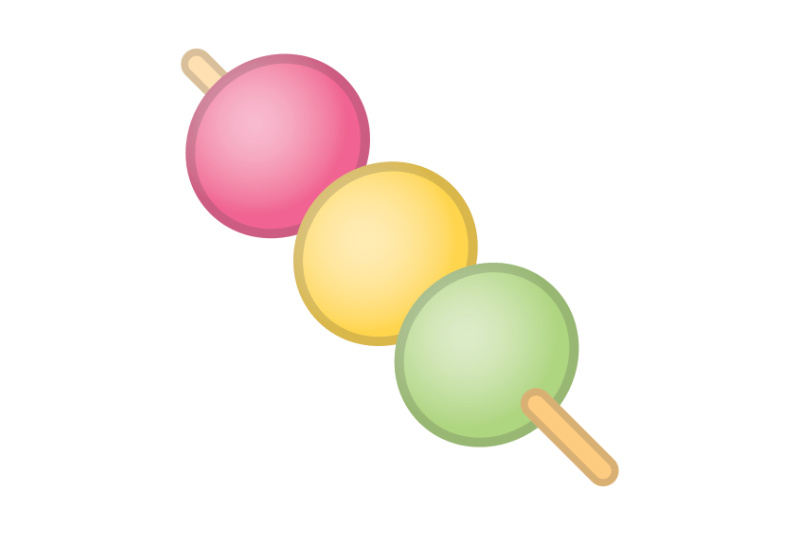
A type of traditional Japanese sweets (wagashi), dango are dumplings made with rice flour and skewered on a stick. The dumplings are mildly sweet with a chewy texture similar to mochi. There are different types of dango, but the one you see here is Hanami Dango (花見団子), which is typically enjoyed during the cherry blossom season.
Did you know? Hanami dango always consists of three colors, pink, white, and green in the order. The colors represent the life cycle of cherry blossoms.
You can purchase 🍡 at the pop-up food stalls during cherry blossom season, or you can make them at home with this recipe:


Kakigori (Shaved Ice) Emoji

You’d see a lot of uses of this Kakigori (かき氷) emoji during the summertime because it is the symbol of a dessert made of shaved ice flavored with syrups, and sometimes with additional toppings such as red bean paste, sweet dumplings, sweetened condensed milk, and ice cream. To make the dessert, you need a special machine to shave the ice into a fine and fluffy texture before it is served in a bowl and eaten with a spoon.
Did you know? Kakigori or shaved ice dessert has a long history where it is said to have already existed in the ancient time during the Heian period. The ice was shaved with a knife into a metal bowl eaten with a sweet sap and doused with some golden syrup on top. It was considered a luxury treat and only enjoyed by the elites.
Nowadays kakigori is a popular sweet loved by all generations and you can find it sold at the summer festivals and food stalls in Japan.
Wish to enjoy some shaved ice 🍧 at home this summer? We have an amazing shaved ice recipe just for you:
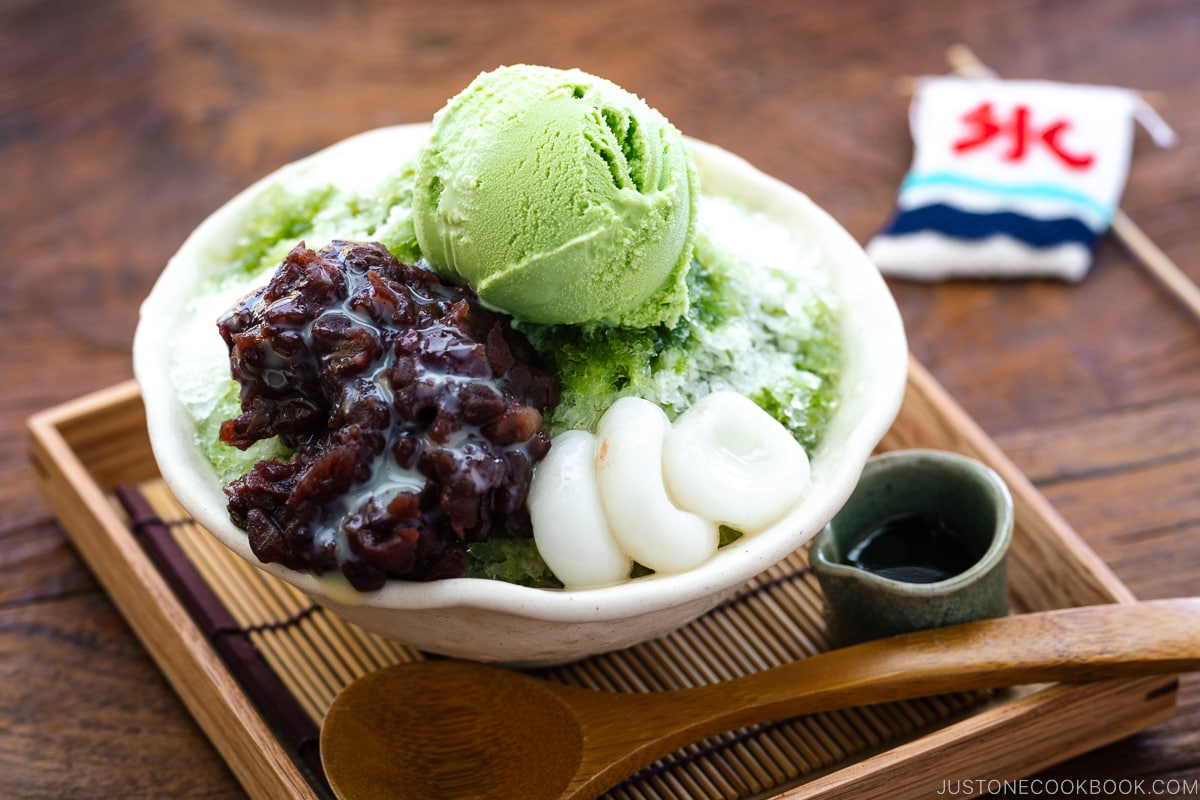

Purin (Custard/Flan) Emoji

This custard-looking emoji is indeed a popular Japanese dessert. Known as Purin (プリン), it is a custard pudding with a layer of soft caramel on top. The texture is silky smooth and slightly firm, with a gentle wobble.
Did you know? Japanese “Purin” available at supermarkets and convenience stores in Japan is all made with gelatin. They are not baked or steamed.
Wish to enjoy 🍮 at home? Here’s the recipe:


Matcha Green Tea Emoji

This teacup with an unmistakable bright green drink is the analog for a special Japanese green tea called matcha. Pronounced as “MA-cha” 抹茶, this iconic Japanese beverage has become just as mainstream as cappuccino in many parts of the world. It is made of finely milled green tea powder that is whisked with hot water using a bamboo whisk and served in special tea bowls at tea ceremonies. These days matcha, the green tea powder, is also widely used in flavoring desserts and sweets and enjoyed in drinks like smoothies and lattes.
Did you know? Matcha is high in antioxidants and a perfect energy booster. Although it has as much caffeine as coffee, it is absorbed by the body at a slower rate and doesn’t give you the jitters. If you are looking for a drink that can give you longer-lasting energy, matcha makes a great alternative.
Check out our matcha 🍵 recipes:
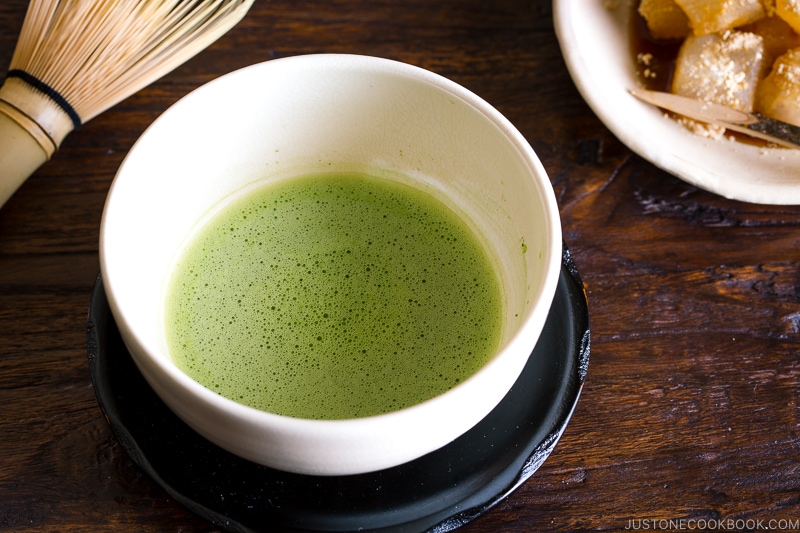

Sake Emoji

Sake (pronounced as SAH-keh, not saki), also referred to as Japanese rice wine, is an alcoholic beverage made from fermented rice and water. Depending on the season or personal reference, sake can be enjoyed chilled, at room temperature, or heated. As seen in the emoji, it is drunk from small cups and poured from a small flask called tokkuri.
Did you know? Traditionally, it is a custom to allow your drinking partner to pour your drink and vice versa. The practice has relaxed in recent years, but it is still widely observed in formal settings, especially when you partake in a drink or a meal with an elderly or someone with higher social rankings.
Just like how wine is used in cooking, sake is widely used in Japanese cooking and is considered an important ingredient in many dishes. To learn more about sake 🍶 in Japanese cooking, read our article here.
Did you enjoy this article?
There are a lot more emojis we could list out here, but we hope the above gives you a good start in familiarizing yourself with basic Japanese food. Do you have a favorite? Are there any Japanese food emojis you’d like to learn more about? Let us know in the comment below!










Great article.
Lousy movie.
[…] Decoding Japanese Food Emojis […]
This was fun to read. I didn’t realize that emoji originated from Japan. Lots of trivia!
It would make a fun party game too!
This was so interesting to read about the meanings of the food emojis. I had no idea emoji originated from Japan. I like how you added a fact for each emoji too!
Thanks, Mel!
That’s brilliant! I actually never really looked at the food emojis except maybe the coffee one and plate & cutlery. But other than that….thanks to your blog post here I realised how many different food emojis there are.
Thank you Nami. It was fun to learn about that. 🍙🍘🍱🍜🍥🍡🥟🍶🍵
Good night from the UK (it’s 1.15am here, I should sleep as we start to work at 8am 😴🙈)
Glad you enjoyed reading the post, Nicole! Did you have a fun dream coded with all the delicious emojis?:)
What a fun idea! 🍱🍱🍱
Thank you!